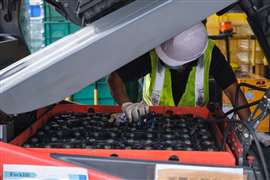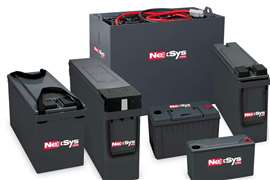PowerXtender additive aims to double lead acid battery life
18 November 2024
In a world ever more filled with electrified equipment powered by high-performance lithium-ion batteries, the tried-and-true lead acid battery still has a place. This traditional battery technology is common in material handling applications, aerial work platforms and other equipment designed for indoor and outdoor use.
One challenge in using these batteries is their relatively short life span — 2 to 4 years for the fast-charging varieties and 3 to 6 years for traditional lead acid batteries. This can be costly for those owning or managing equipment fleets, especially larger ones.
One company said it has engineered a solution that can extend the life of lead acid batteries. Slovakia-based PowerXtender makes a liquid additive designed to make lead acid batteries last longer. In the U.S., the product is distributed by Minnesota’s PowerBatt, which also lends its name to the product.
 A technician inspects a forklift battery. (Photo: pongsakorn via Adobe Stock)
A technician inspects a forklift battery. (Photo: pongsakorn via Adobe Stock)
Power Progress’ sister publication International Rental News (IRN) recently interviewed Dušan Uhrík, founder and CEO of PowerXtender, and PowerBatt President Christopher French. Editor Lewis Tyler of IRN sought to learn more about PowerBatt and its application.
All About Chemistry
Uhrík said that the additive was originally developed for use by the Czechoslovak military.
“We came across and have been able to purchase the patented formula and developed it,” he said. “Over the years, we have developed it into the way that it is used today, very user-friendly and without any kind of machines being used. It’s a simple additive.”
French explained the way PowerBatt works.
“This is really all about chemistry, and chemistry can be complicated,” he said. “But it’s really quite simple. The byproduct of lead acid battery technology is crystalline sulfate. We have come up with a technology that can convert it back into electrolyte, or battery acid, if you will.”
French said this is a critical aspect of the additive because crystalline sulfate “kills” batteries.
“Every lead acid battery on the planet eventually is going to die because of that crystalline sulfate,” he said. “So, we have come up with an environmentally friendly way actually to reverse that impact.”
According to Uhrík, the efficacy of the additive depends upon ambient conditions as well as how soon a user begins the application.
“Obviously, in certain regions of the world where it’s very hot or very cold, the batteries last less than in normal conditions — for example, in Europe,” Uhrík said. “But we like to say, because we have experience and data proving it to the customers, that when used properly, we can easily double the life of any lead acid battery.”
Easy Application
French described the process of using the additive. “The application is quite simple. For anybody who’s ever watered a battery, it’s the same process. You can literally use a syringe, like a 300cc syringe, and you can apply it to each cell of the battery with the syringe.
“There are other methods, as well. For batteries that have watering systems, we have pumps and connections that connect to those, where we can apply the PowerBatt to an entire set of batteries. For instance, in a golf car, you’re probably going to have six batteries. We can apply PowerBatt to all six batteries simultaneously.”
Uhrík added, “The volume that goes into each cell is calculated by the ampere-hours of the battery, so very simple.”
PowerBatt only needs to be applied to the battery twice per year, French said. “You do not have to disconnect battery cables. You don’t have to pull batteries out of machines. You don’t have to empty out electrolyte — none of that. You simply add PowerBatt twice a year, and that’s all you need to do.”
PowerBatt is currently being used with batteries in a variety of equipment applications.
“We have customers reviving batteries from small motorcycle scooters up to golf cars, aerial platforms, and a majority of our customers actually use them in batteries powering forklifts because they are extremely expensive,” Uhrík said.
Benefits and Differentiators
According to French, the main benefit of using PowerBatt is cost savings.
“The average lifespan of a battery here in the [U.S.] is about 4 years,” he said. “If we can extend that to 8 years, they just cut their battery expenses in half.”
French added that energy savings is another benefit. “A good example of that would be golf courses. You might have 75 golf cars that have to be charged every night, and they all have an individual charger connected to them. That is a huge expense for golf courses. So, we can — through the efficiency of the battery using PowerBatt — we can cut those energy costs by up to 25 percent.”
While French said that there are competitive products on the market, none are as effective as PowerBatt.
“They simply don’t have the proper chemistry,” he said. “The other issue is none of them have been able to pass the tests that we have gone through and passed, which are ISO 17025 field testing.”
According to ISO, the 17025 standard “enables laboratories to demonstrate that they operate competently and generate valid results.”
“Most of the competitors — they don’t even try, because they know that they cannot pass those tests,” French said. He added that PowerBatt has also been well received by the U.S. government.
“A couple years ago, I sent our technology to the Department of Energy of the United States, and they actually called me back, which is unusual, because they were very interested in the technology,” French said. “They wanted updated data and testing on the technology. And that’s how we ended up at Electric Applications Inc. This is one of the top battery technology testing labs in the United States, and we were directed there by the Department of Energy, and we are the only additive they have ever tested over 30 years that actually got certified — the only one.”
In addition to the U.S., Uhrík said the additive has a global distribution footprint.
“We are already distributing the product to several countries in Asia — Indonesia, Phillippines, Bangladesh, Singapore. Now we’re talking to Mexico and obviously Europe, and South America. So, it’s spreading.”
Uhrík added PowerXtender is also in talks with several countries in Africa.
STAY CONNECTED



Receive the information you need when you need it through our world-leading magazines, newsletters and daily briefings.
CONNECT WITH THE TEAM










